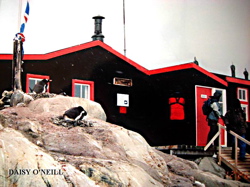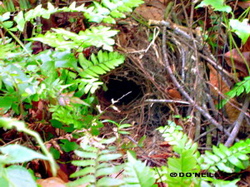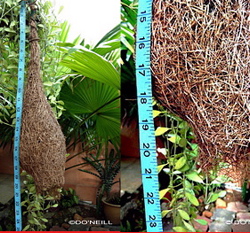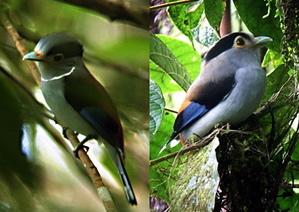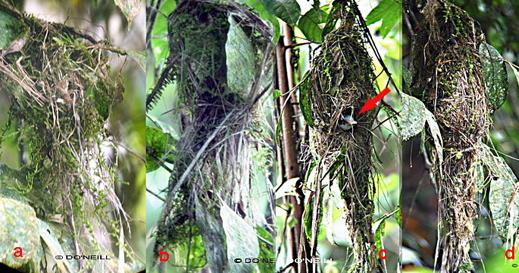Human beings build houses to live in, many turning them into homes to raise a family. Birds build nests to breed their young; well… most of them do anyway. They fledge their chicks and then, let them go.
Bird nests come in different shapes, sizes, of variable nesting materials and in different conducive habitats. Such as Gentoo Penguins (Pygoscelis papua) of Antarctica – they build their nests using rock chips as shown in this image (left).
There are birds that build huge nests that are suspended from tree canopies. Some birds build on ‘Y’ forks of tree branches and many bigger birds like raptors, choose tree canopies. There are also ground nesters, cavity nesters, nesters on water reed clumps, nesters on cliff edges, roof edges of buildings or birds that build no nests at all.
A few rogue species choose the easy way out by parasiting eggs on nests of another species. They leave their eggs to be incubated and their young to be fed by their unsuspecting hosts, who in addition to raising an oversized, ugly chick, risk their own being pushed out by the parasitic chick.
The image on the right shows the ground nesting site of the Blue-winged Pitta (Pitta moluccensis) in a Malaysian tropical fruit orchard.
In Malaysia, Baya Weavers (Ploceus philippinus) of approximately 15cm, reign supreme in building large nests in comparison to their sizes (left top). Let us take a closer look at a Baya Weaver’s nest. The used nest was retrieved from a jungle environment before it had to give way to housing development (left bottom).
If we are to dismantle the nest and start counting the number of straws that made up this nest, how many trips does one think the male bird or birds have to make? Assuming that one straw is equivalent to one trip – a ‘to and fro’ from the nesting site, we are talking in terms of hundreds of trips, if not, into a thousand easily.
Surely, one can just sympathise with birds for having to make marathon flights to build just one avian mansion and for one time use only!
That’s how hard and intensive birds have to function in the name of reproduction; which genetically, what all living things are designed primarily for. The Avian Kingdom is no exception.
Most of the time, the female birds get to choose their partners in ensuring the fittest will only do for the survival of their species. As in the case of the Baya Weaver, the female gets invited to view his weaving skills for her approval. An ideal and successful suitor seems usually the one who claims to build a strong, pear-shaped nest with a long funnel opening at the bottom.
The total length of the nest could be a minimum 48cm as shown in the image (right, scale in inches). (Unfortunately, much of the funnel trimmings have disintegrated over time). What happens if the nest does not meet the approval of the female? Below is an image of a half built ‘avian mansion’ – an anatomically looking human uterus – with a dejected, perhaps inexperienced male weaver whose body language said it all. “You got to be kidding to think you can get me into that human bellows” bellowed the females.
Another abandoned nest shows a forgetful, avian architect leaving out the floor plans for an entrance door, to an almost complete mansion (below). The female bird took off aghast without another look!
Broadbill species are a much sought after by bird watchers and photographers alike as looking for their nests is like a treasure hunt. When found, the depilated looking mansion is really nothing much to admire but rather, a scrappy, untidy extended oval nest with a side entrance (below).
For such pretty birds, I consider them not very intelligent. Their choice of nesting sites indiscreetly overhang from canopies, often along walking trails or above water course for the whole world to see.
Considering their breeding season which stretches variably from February to September for most species, yet their population is small and sightings are far and few in between. Could low population rate be due to broadbills’ indiscrete choice of nesting sites, resulting in their nests becoming easy targets to predation from wild animals like squirrels, monkeys, snakes, other birds and most of all – Homo sapiens? (That’s us! That’s us!)
Imagine a gang of avian paparazzi with bazooka lens, with hoods as big as baking tins, flashing to their hearts’ content at nests to get just that perfect shot? If nests were within the reach of uncaring hands, would anyone care to think what would have happened to the parents, eggs or the chicks?
Their cousin, the Dusky Langur (Trachypithecus obscurus) with a painted looking ‘Black & White’ Minstrel’ would behave no better (right). Birds’ eggs for breakfast is very much on his mind.
Let’s take a rare glimpse of a nest executed by a pair of Silver-breasted Broadbills (Serilophus lunatus), Luke and Lucy. It was a lucky opportunity to be able to observe the progress of nest building on three consecutive days during a short a birding retreat.
The images on the left show two vines tied together to form the anchor support for the nest. The entwining process is interesting. It was a pity to have missed observing that initial stage. When the first observation was made, the pair had it completed and was
already beginning the second stage of making the proper nest. Lucy, the female broadbill is recognised by a thin silver gorget like a thin white necklace over her upper breast. She played the role of inspection as well (right).
Imagine, if humans were to be given a ten metre rope and be asked to have it wrapped around a tree trunk firmly with just one hand. I would be running in circles and going nowhere! In the case of the Silver-breasted Broadbills, only a pair of beaks were required to transform straws, foliages, twigs and moss into a made-shift home to last good for a month or so.
The second and third day of nest building proceeded well and the nest was taking shape. Observation was kept at a distance, a minimum of 10 m away, without disrupting their routine. I left on the third morning (below: a,b).
I kept my pledge to send no images to anyone prior to chick fledging. I informed no one of the active nesting site, apart from two birding pals and guest I was birding with, when Luke and Lucy’s nesting site was discovered.
Twenty-one days later, I returned to check on Luke and Lucy’s progress. This was what I saw. A completed nest laced over with moss and a matured bird inside the nest (above: c,d).
This closing chapter was written on the 38th day (Counting from day one of nest building) – my final visit to Luke and Lucy’s mansion. There wasn’t anyone at home. No sighting of any chicks seen in any of my, out of town, trip visits- total 4, over a 38 day period (left).
Did the chicks fledge? Or…. were the parents incubating dud eggs and decided to have a quick break together to reconcile their failure? Readers decide…. For such is the tough life of builders of avian mansions on marathon flights.
SUBMITTED BY DAISY O’NEILL (Avian Writer), PENANG, MALAYSIA.
(No flash photography used in any of the provided digiscoped images. On site observations of the broadbills were carried out in least time spent possible. Images of nests shown were those of chicks that had fledged or abandoned)|


